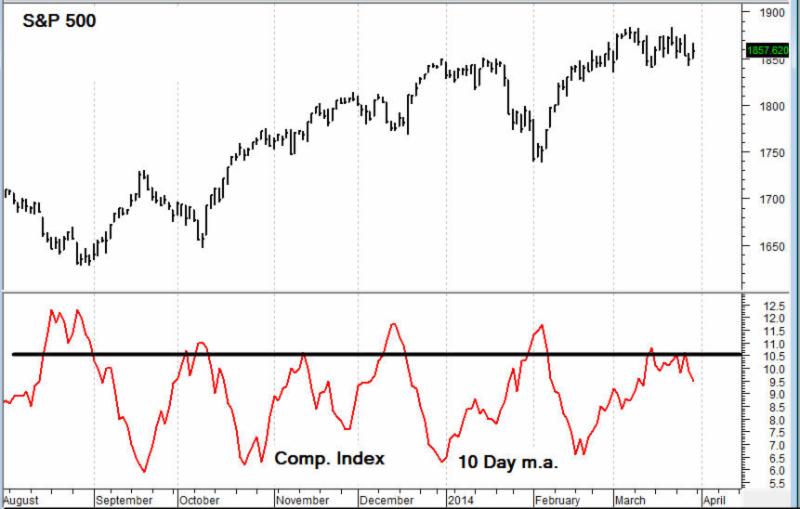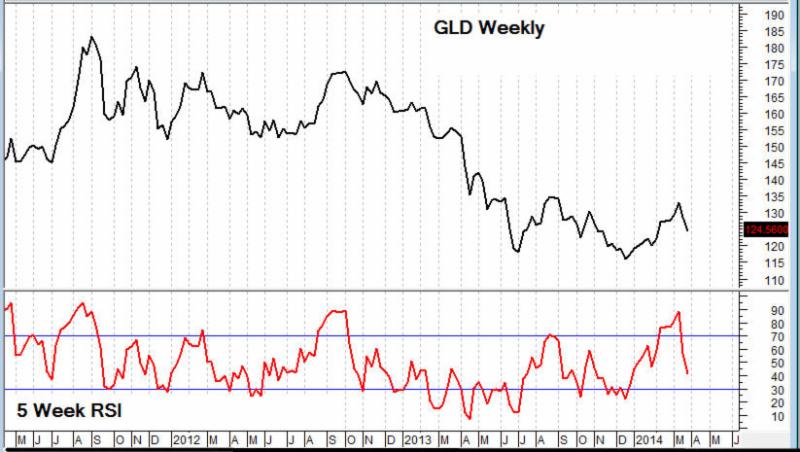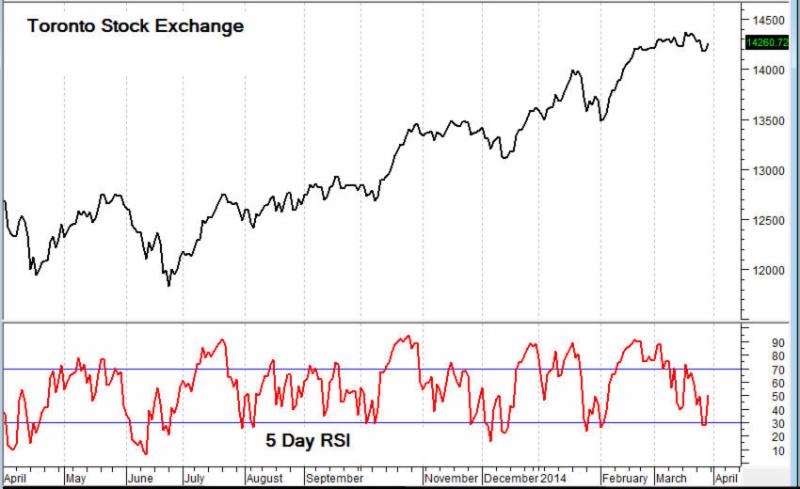Timing & trends
We have a bit of a dilemma. There are far too many bulls to justify further price appreciation, but a number of our gauges are oversold which would suggest that the market wants to go higher.
Note the put call ratio. It was just at the lowest it has been in several years. That would suggest trouble in the not too distant future. Option buyers are among the worst of all market prognosticators.

HOWEVER SOME GAUGES ARE OVERSOLD.
On the other hand the 10 day moving average of the Composite Index is near levels that, in the past, have portended upward price movement.
Were it not for gauges like this, I would strongly believe that we are topping out, but this makes us scratch our heads. I rarely do this. I like to take a stand, but right now I’m a bit confused by the disagreement among indicators.

GOLD
The chart of the GLD, or gold ETF is bearish, but it’s trying to put in a bottom. The immediate problem is that the rally over the first couple of months has gotten 5 week RSI overbought.

Toronto Stock Exchange
The chart of the Toronto Exchange is clearly in an uptrend. One only has to look at the chart to see that. It’s moving from the bottom left to the top right. Not only that, but note that 5 day RSI is just coming off an oversold condition. This should support higher prices.

Trading For March
For the past month, the nightly hotline’s trading recommendations profited by 2.71 SSO points. The SSO itself gained 1.55 points.
The S&P 500 gained 0.69% for February. Our trading gained 2.61%. This is because the SSO is constructed to outperform the S&P 500 by roughly 2 to 1. The chart below shows our trading progress since October of 2012.

FINAL THOUGHTS
On Monday, the last day of March, Janet Yellen spurred the markets by saying that the U.S. economy and job market are far from healthy. So to combat this, she and her colleagues on the Fed will continue to do what hasn’t worked over the past five years. Amazing.
She feels that she can do this because there is “no inflation” Really? Gasoline has more than doubled over the past 5 years and food has also more than doubled. College tuition is soaring. Health care is going up sharply. Please. Spare me your 0.2% increase. in CPI.
Today we finished the first quarter of an intraday hotline. We charge only if you’re satisfied after each three month. We will be coming out shortly with the track record.
Stephen Todd, Editor and Publisher P.O. Box 4131, Crestline, CA 92325-4131
Registered Investment Advisor Phone 909 338 8354909 338 8354909 338 8354
www.toddmarketforecast.com Issue 4 Year 29 e-mail -toddmarketforecast@yahoo.com
April 2014 Due the first Tuesday of each month.
 All governments had better open their eyes for we are on the brink of a major convergence between both the Cycle of Civil Unrest, Civil War & Revolution and International War. Both of these models converge and as I pointed out at the Cycles of War Conference, this is the first time we have seen this convergence since the 1700s.
All governments had better open their eyes for we are on the brink of a major convergence between both the Cycle of Civil Unrest, Civil War & Revolution and International War. Both of these models converge and as I pointed out at the Cycles of War Conference, this is the first time we have seen this convergence since the 1700s.
This is no plain modern event with civil unrest erupting because of an interconnected world. These are grassroots uprisings cross-fertilized perhaps from a world contagion yet they often have similarities – corrupt governments. Turkey, Ukraine, Thailand, Venezuela and Bosnia-Herzegovina are all middle-income democracies with elected leaders besieged by people angry at misgovernment, corruption and economic sclerosis. These days it is no longer just dictators who have something to fear from the crowd. This is the promise of Marxism that centralized planning and false promises are coming home and governments are too corrupt and incompetent to deliver what they have claimed for decades.

Communism is dead. The socialistic agendas that have lined the pockets of government and filled the coffers of banks is over. The national debts are on average composed of 70% interest payments not programs to help the poor as marketed. The debts that keep growing with no intent upon paying anyone back are draining the national productivity and turning the people into economic slaves. The standard of living has declined and it now takes two incomes to survive where one use to be just fine. Women won the right to work and lost the right to stay home.

The promises that you save for the future have collapsed into dust as interest rates have been driven lower making savings utterly worthless. There is no such thing as saving and living off your fixed income. The elderly are being driven back into the work force and the whole ideas that a generation believed in are vanishing before their eyes.
So it is no longer communists and dictators that are the targets. All governments are now the targets and when the economy turns down after 2015.75, the threat of civilization will be pulled apart by the self-interest of politicians clinging to power to the detriment of the people.
also from Martin:
French dealt an Unprecedented Defeat to Hollande’s Socialist Party
North Korea Fires Artillery Shells in the South As they Return Fire
 A bad dream jolted me awake one morning last week: the economy had crashed, the banks were shuttered, commerce had ceased, the stores were stripped bare and rioting was everywhere. This bleak vision is not unusual for anyone who has imagined what the U.S. economy is going to look like when the ponderous hoax that sustains it has been fully revealed.** What was most troubling about the dream was that the collapse evidently had taken me and my friends by surprise. The survivalist inventory that we were supposed to have kept in our basements had gone unfulfilled. Still worse, the things we needed most were nowhere to be acquired: food for six months, medical supplies, batteries, ammo, emergency generators, toilet paper, etcetera. In the dream, a friend, a successful financial adviser who has provisioned his retirement generously, was scurrying around town on a vintage motorcycle with a sidecar, trying to scrounge essentials that he had not thought to store against a civilizational emergency.
A bad dream jolted me awake one morning last week: the economy had crashed, the banks were shuttered, commerce had ceased, the stores were stripped bare and rioting was everywhere. This bleak vision is not unusual for anyone who has imagined what the U.S. economy is going to look like when the ponderous hoax that sustains it has been fully revealed.** What was most troubling about the dream was that the collapse evidently had taken me and my friends by surprise. The survivalist inventory that we were supposed to have kept in our basements had gone unfulfilled. Still worse, the things we needed most were nowhere to be acquired: food for six months, medical supplies, batteries, ammo, emergency generators, toilet paper, etcetera. In the dream, a friend, a successful financial adviser who has provisioned his retirement generously, was scurrying around town on a vintage motorcycle with a sidecar, trying to scrounge essentials that he had not thought to store against a civilizational emergency.
A Stark Fact
Do we dare doubt that such a day awaits? If you’re having trouble sorting out the possible reasons why, and if you can’t quite wrap your mind around the certain, deflationary collapse of the banking system’s quadrillion-dollar derivatives bubble, consider just this one fact: Millions of 20- and 30-somethings working in low-wage jobs and in debt up to their eyeballs will be footing the bills for the Baby Boomers’ Social Security and Medicare. And now consider this stark fact: Each and every day between now and 2030, 10,000 Baby Boomers, relatively few of whom are financially prepared for retirement, will reach the age of 65. If you think there must be a workaround , some path other than mass destitution and tightly rationed health care, then you don’t understand the problem.
So why, if I’m so certain that economic catastrophe awaits, have I not completed the steps needed to prepare for it? A similar question must have troubled Jews in Germany as the Nazi threat turned genocidal. Even before Kristallnacht, the handwriting was literally on the wall for them, just as it is for those who understand that a global economy sustained by statistical lies, bread-and-circuses government, promiscuous consumer borrowing and a financial shell game of cosmic size cannot end other than badly. Very badly. But like those Jews who chose not to leave Europe, I find myself frozen in place by the very small hope that my worst fears will somehow not come to pass. To imagine otherwise is to court visions of ruin that, for me at least, are just too unsettling to think about.
Edicts Won’t Revive Trust
Meanwhile, I wonder whether those of us who are only half-prepared will ultimately fare any better than those who have taken no steps at all. Anyone in the latter category is implicitly betting that Big Government will take care of each of us if the economy collapses. This is not merely stupid, it is crazy. Washington can’t even run a web site, much less manage the hardships of a Second Great Depression. More likely is that the Government will ratchet up its current campaign of statistical lies to persuade us that things aren’t nearly as bad as they seem. On the inevitable day that the banks don’t open, we will be told that the Obama administration is working on a plan to keep money and credit flowing. This problem will remain unsolved for a week, and then a month, at which point people will come to understand that barter among themselves is the only answer. President Obamacare and his political toadies will discover then that credit flows on trust alone, and that once that trust fails, it cannot be revived by issuing edicts, or extending deadlines, or forgiving the “non-compliant”. We can only pray that when that point is reached, distrust in Big Government has become so deep and pervasive that neighborhoods, towns, cities, county and states will be left alone to practice the long-lost virtue of self-sufficiency.
 Quietly this past week, Canadian Natural Resources Minister announced the Government of Canada’s approval of four long-term liquefied natural gas (LNG) export licences for Pacific NorthWest LNG, Prince Rupert LNG, WCC LNG and Woodfibre LNG.
Quietly this past week, Canadian Natural Resources Minister announced the Government of Canada’s approval of four long-term liquefied natural gas (LNG) export licences for Pacific NorthWest LNG, Prince Rupert LNG, WCC LNG and Woodfibre LNG.
The four export licenses combined will allow for the export of up to 73.4 million tons of LNG per year.
Along with the announcement Minister Rickford stated that Canada (the West Coast specifically) is well positioned to help meet the growing market demands for liquified natural gas. LNG from Canada’s West Coast can get to Asian markets in less than two weeks compared with the month it takes a tanker to leave from export terminals in the Gulf of Mexico.
“World energy demand is on the rise, and Canada has the unprecedented energy supply to meet that demand,” he said in a statement.
These are hardly revelations but support a theme we have been covering for quite some time now and have already benefitted from the anticipation on this coming boom in a number of the oil & gas service companies we have recommended over the past year. Having said this, the true benefits in terms of hard cash flow remain likely more than a year in the future. But they may last for decades.
At this stage, we are likely only in the first inning. But, we would not be surprised to see some hiccups along the way. These will provide long-term opportunities for investment in solid companies. At this stage, our bias is towards service energy and infrastructure service stocks with existing strong businesses which are positioned to benefit from a B.C. LNG boom if and when it occurs but can stand on their own two feet without it. We already have 2-4 of these types of companies in active coverage with built in gains that are positioned for potential explosive growth if the boom does in fact take place.
Quick LNG Related Stats
- Canada is the fifth-largest producer of natural gas in the world and has up to 37 trillion cubic metres of marketable natural gas resources, enough to meet our current production for over 250 years.
- The International Energy Agency’s 2013 World Energy Outlook predicts world energy demand will increase by 33% by 2035. The rapidly rising economies of China, India and the Middle East will drive growth, commanding more than 58% of the rise in global energy demand. India’s energy needs alone will double over this period.
- The Conference Board of Canada estimates that potential growth in British Columbia’s natural gas sector alone could attract $180 billion in new investment and create 54,000 jobs per year between 2012 and 2035.
- Each Canadian LNG facility will be subject to a thorough environmental assessment and regulatory review to ensure it can be developed safely.
On Wednesday, a report authored by RBC Dominion Securities Inc. singled out Pacific NorthWest LNG (led by Malaysia’s state-owned Petronas) as the B.C. project that has been taking large strides toward reaching the goal of supplying energy-thirsty customers in Asia.
“Pacific NorthWest LNG has established a high degree of momentum, with a final investment decision expected by the end of 2014,” according to the global study by RBC’s energy team headed by Greg Pardy and Kurt Hallead.
Pacific NorthWest LNG, one of 14 projects proposed for British Columbia’s coast, has grabbed headlines of late as the Malaysian government adds new Asian partners for the joint venture.
Pacific NorthWest LNG estimates that almost $36-billion will need to be spent in order to make its export plan a reality in late 2018. The massive budget includes nearly $11-billion for the export plant to be built at Lelu Island, near Prince Rupert.
The West Coast LNG boom is by no means a slam dunk at this stage as global competition, environmental issues, funding and the tax regime are amongst a number of issues still to play out.
Start with the B.C. government’s document on its proposed new tax regime. To date, the information provided publicly consists of a short two-page backgrounder tabled just over a month ago along with the provincial budget.
The short document indicated a two-tier income tax on LNG production, with 1.5% to be charged on net proceeds up front and a second rate of “up to 7%” scheduled to kick in once the operator’s capital investment has been covered.
Opponents including Jack Mintz, economist at the school of public policy at the University of Calgary, who also happens to be a director of Imperial Oil (a company that has a stake in one of the proposals to develop B.C. LNG) points out that B.C. already taxes natural gas by collecting royalties on the extraction of the resource at the wellhead. But as Mintz notes, the proposed special tax would impose a rather atypical second levy on processing of the resource in liquefied form.
“Applying a special tax on LNG is akin to applying special refining taxes in oil and gas and mining or manufacturing phases in forestry, which has not been pursued by other provinces,” noted Mintz.
While we believe the sitting B.C. government, which has made the development of LNG a priority, will eventually implement a competitive tax regime, the current uncertainty and/or lack of a competitive structure could help serve to derail some of the capital investment that will be necessary to develop a number of the large scale proposed projects. Corporate capital is mobile and will not wait in limbo forever as a country dithers in red tape for environmental work, special tax regimes and other special interest groups to have their pound of flesh. Eventually, the capital is employed elsewhere.
Additionally, Canada is trailing the United States in the North American LNG export race, RBC cautions. The United States has the advantage because major proposals south of the border are “Brownfield” projects that call for reconfiguring existing import facilities and converting them to process LNG exports. By contrast, Canada is relying on “Greenfield” projects that effectively mean starting from scratch.
RBC also noted that Australia is emerging as an LNG heavyweight, bolstered by seven export projects under construction.
“Australia is set to eclipse Qatar as the largest global supplier of LNG by 2018,” the report said. Australian Greenfield LNG projects, however, have been stung by cost overruns.
Again, we believe it wise to have exposure to the potential LNG boom, but we stress it be done prudently with a bias is towards service energy and infrastructure service stocks with existing strong businesses which are positioned to benefit from a B.C. LNG boom if and when it occurs but can stand on their own two feet without it.
|
KeyStone’s Latest Reports Section |
Gold Fibonacci Arc Bull Confirmation Charts Analysis
Silver Perfect Pullback Charts Analysis
US T-Bond Monthly Charts Analysis
Gold Stock Trade Strategy Charts Analysis
“Our main format is now video analysis…”
Above are today’s videos
Thanks,
Morris
Ed Note: One of the reasons this analysis is so clear comes from the full page Big Charts you see when you click on each link above. Below is an example of a chart in a smaller form. Morriis walks you through the analysis in a very clear and thorough manner – Editor Money Talks














